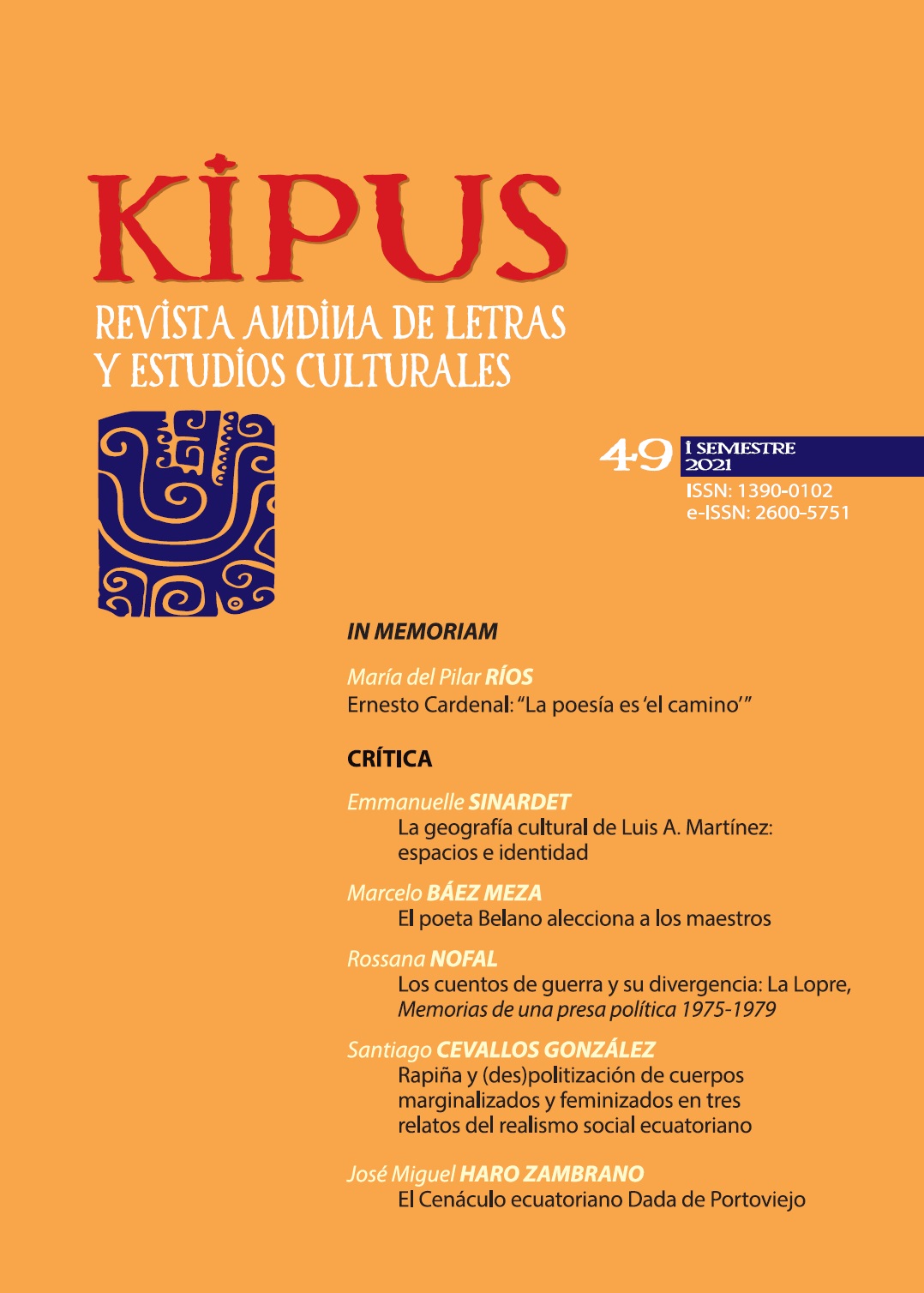The Ecuadorian Dada Cenacle of Portoviejo
DOI:
https://doi.org/10.32719/13900102.2021.49.6Keywords:
Ecuador, Dadaism, Ultraism, Hugo Mayo, Cenacle, Dada, new spirit, Portoviejo, Manabí, avant-garde, poetryAbstract
This paper is the result of an investigation that set out to understand the emergence of Dada-ism in 1922 in the city of Portoviejo, capital of the province of Manabí, Ecuador. Considering that this city on the Ecuadorian coast was at that time predominantly rural and was the scene of violent disputes between liberals and conservatives, it was unlikely that an artistic manifestation of this type might be possible, far from the great cultural centers and industrialized metropolises. To explain the emergence of this poetic current, the author explores the histori-cal and aesthetic development of Dadaism and its transmission through cultural magazines that established the link between large European cities such as Zurich, Paris and Madrid with Ecuador and the city of Portoviejo. In addition, the author suggests a possible unveiling of the real names that have so far been concealed by the pseudonyms under which the Portoviejo Dadaists presented themselves.
Downloads
References
Apollinaire, Guillaume. 1913. Les peintres Cubistes: méditations esthétiques. París: E. Figuiére.
–––. 1918, “L’Esprit nouveau et les poètes”. En Mercure de France. Tomo CXXX (noviembre-diciembre): 385-96.
Bachelard, Gaston. 1992. Fragmento de una poética del fuego. Buenos Aires: Paidós.
Bernstein, Ariel. 2007. “España en Borges”. Clarín. Revista de Literatura. 7 de mayo. https://revistaclarin.com/569/espana-en-borges/.
Borges, Jorge Luis. 1919. “Himno del mar”. Grecia (37) (31 diciembre): 3-4.
–––. 2007. Textos recobrados (1919-1929). Buenos Aires: Emecé.
Calderón Chico, Carlos. 1985. “Conversación con el poeta Hugo Mayo”. En Literatura, autores y algo más. Quito: Offset Graba.
Enero, Rodrigo. 1922. “Madrigada”. Iniciación 1 (10): 13.
Gómez González, José. 1922. “Noches de luna”. Iniciación 1 (5): 16.
Granés, Carlos, 2011. El puño invisible. Arte, revolución y un siglo de cambios cul-turales.Madrid: Taurus.
Haro, José, 2019. “Espacio y tiempo imaginados en El Cenáculo Dada (1922). Ultra poesía de Portoviejo en la revista Iniciación (1921-28)”. Tesis de maes-tría, Universidad Andina Simón Bolívar, Sede Ecuador.
Hidrovo Velázquez, Horacio. 1922. “Las nuevas formas”. Iniciación 1 (4): 20.
–––. 1922. “Las 5 p.m.”. Iniciación 1 (7): 22.
–––. 1929. Cauce. Guayaquil.
Julio, José. 1922. “Visión vesperal”. Iniciación 1 (7): 22.
Marzo, Jorge. 1922. “Óptica húmeda”. Iniciación 1 (5): 16.
–––. 1922. “Psicografías”. Iniciación 1 (7): 22.
Mayo, Hugo. 1919. “De jardín”, “Drogas” y “Viaje”. Cervantes (octubre 1919): 51-53.
–––. 1919.“Oxidación”. Grecia (31): 3.
Molina Cedeño, Ramiro. 2009. Historia de Portoviejo. Quito: Ediciones La Tierra.
Ortega y Gasset, José. 2007. La deshumanización del arte y otros ensayos. Madrid: Espasa-Calpe.
Robles, Humberto. 2006. La noción de vanguardia en el Ecuador. Recepción, trayectoria y documentos 1918-1930.Quito: Universidad Andina Simón Bolívar, Sede Ecuador / Corporación Editora Nacional.
Sarmiento, José Antonio. 2013. Las veladas ultraístas. Cuenca: Universidad de Castilla, La Mancha.
–––. 2016. Cabaret Voltaire. Cuenca: Universidad de Castilla, La Mancha.
Septiembre, Alfredo. 1922. “Fotóptica”. Iniciación 1 (8): 25.
Torre, Guillermo de. 1959. Claves de la literatura hispanoamericana. Madrid: Taurus Ediciones.
–––. 1968. Ultraísmo. Existencialismo y objetivismo en literatura. Madrid: Guadarrama.
Videla, Gloria. 1963. El ultraísmo, estudios sobre movimientos poéticas de vanguar-dia en España. Madrid: Gredos.
VV. AA. 1922. “Explicando el jeroglífico”. Iniciación 1 (8): 15-8
Downloads
Published
How to Cite
Issue
Section
License

This work is licensed under a Creative Commons Attribution-NonCommercial-ShareAlike 4.0 International License.







.png)
